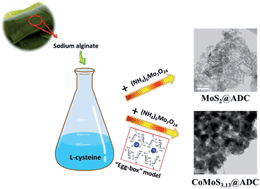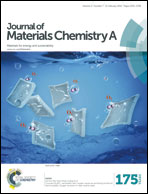Biomass-mediated synthesis of carbon-supported nanostructured metal sulfides for ultra-high performance lithium-ion batteries†
Abstract
A bio-inspired, environmentally friendly route to prepare three-dimensional (3D) hybrid nanostructured materials for lithium-ion batteries (LIBs) is presented. Alginate, a naturally occurring biopolymer, was employed as a template to synthesize molybdenum sulfide (MoS2) nanostructures from ammonium heptamolybdate and L-cysteine precursors under physiological conditions. Here we show that MoS2 precursors did not interact specifically with alginate; instead, MoS2 nanocrystallites were precipitated within a porous alginate matrix made up of hollow nanospheres. In contrast, when cobalt (Co2+) was added to crosslinked alginate mixed with ammonium heptamolybdate and L-cysteine precursors, a highly crosslinked hydrogel network was obtained instead. Upon annealing, CoMoS3.13 nanocrystallites were found to be well-dispersed within a 3D porous carbon matrix (CoMoS3.13@ADC, ADC represents alginate derived carbon). The novel CoMoS3.13@ADC hybrid materials were evaluated as anodes in lithium ion batteries, and were found to have exceptional capability performance, excellent cycle stability and rate performance. The lithiation mechanisms of CoMoS3.13@ADC were proposed; the shortened ion transport paths and rapid reaction kinetics were due to the nano-sized CoMoS3.13 crystals and inter-connected 3D porous structure. In summary, we showed that alginate biopolymers could offer a facile route towards the synthesis of novel 3D metal sulfide hybrid nanomaterials for energy storage applications.


 Please wait while we load your content...
Please wait while we load your content...